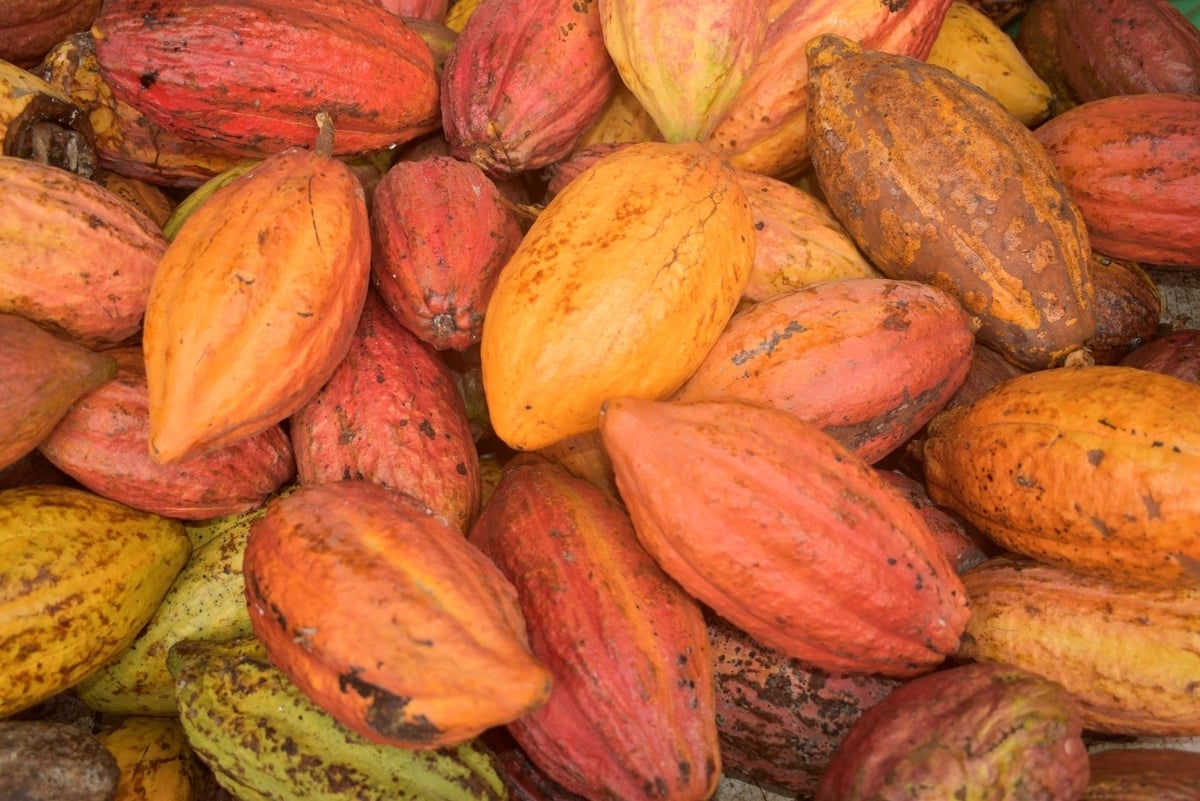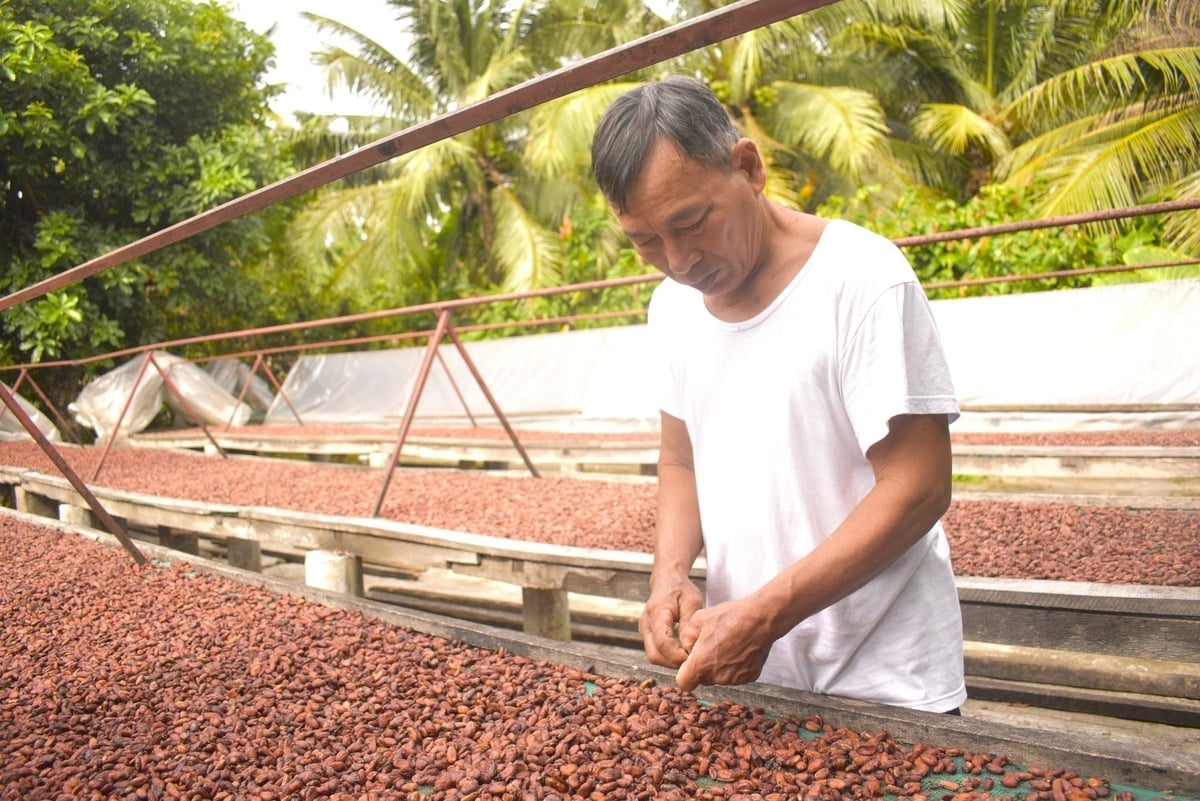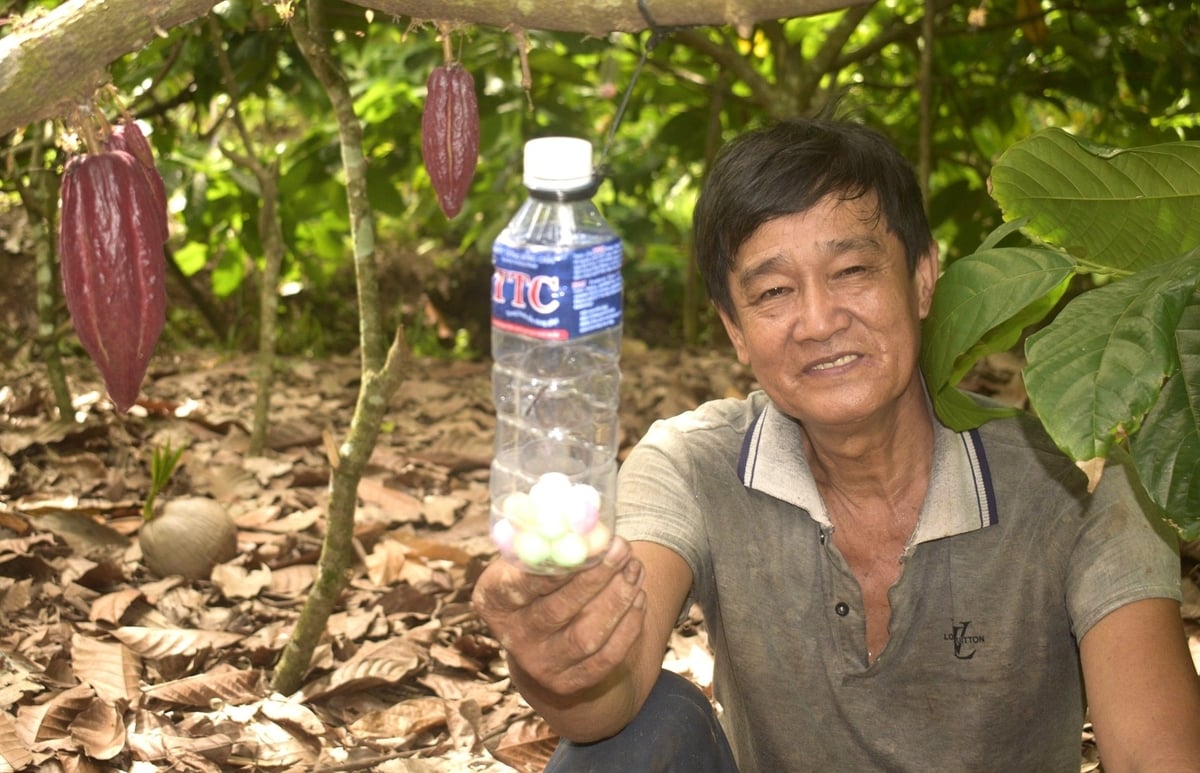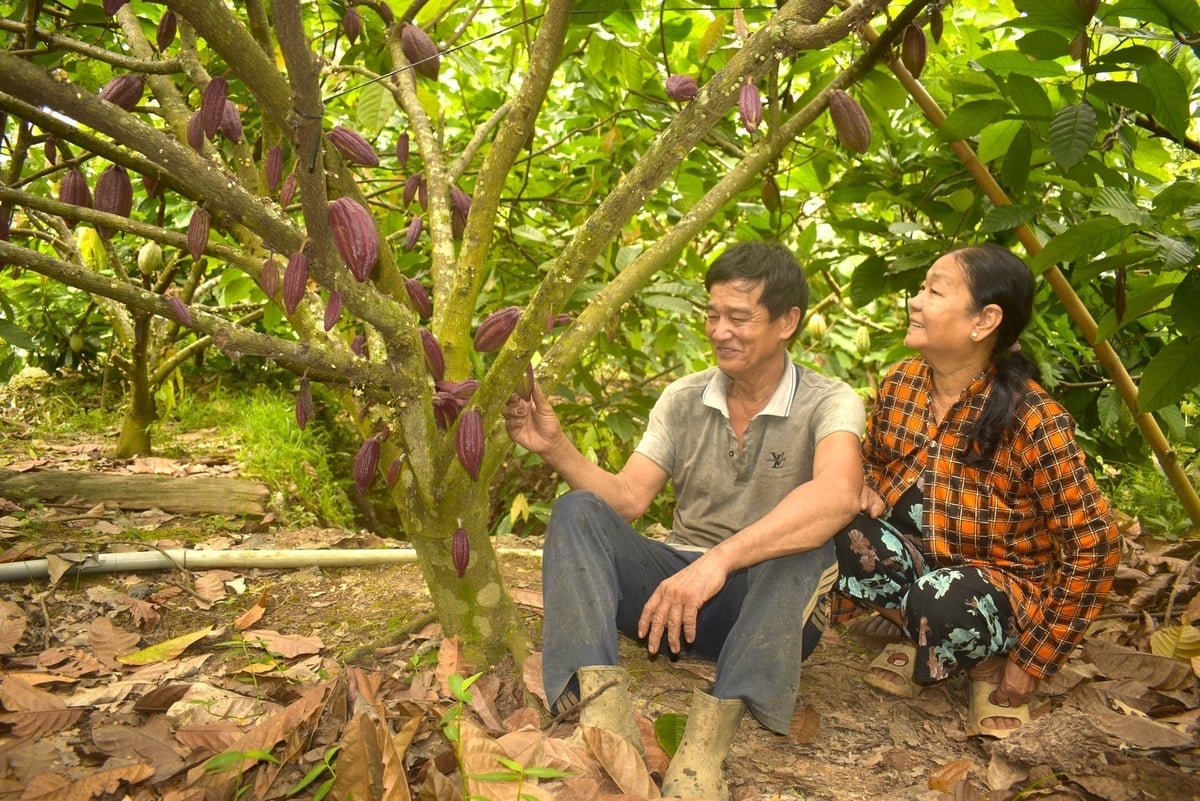October 25, 2025 | 00:15 GMT +7
October 25, 2025 | 00:15 GMT +7
Hotline: 0913.378.918
October 25, 2025 | 00:15 GMT +7
Hotline: 0913.378.918
After a period of decline due to falling prices and the impact of saltwater intrusion, cacao trees in the Mekong Delta, especially in Vinh Long Province, are gradually recovering. This comeback is tied to a new wave of planting, with enterprises partnering with farmers and capitalizing on global market opportunities as cocoa prices repeatedly reach new highs.
More than a decade ago, cacao was regarded as one of Ben Tre’s most promising crops (which is now part of Vinh Long) with hundreds of hectares, peaking at over 10,000 ha in 2013. Much cacao was intercropped with coconut palms, a “two-tier, three-benefit” model that shaded and preserved moisture for coconuts while making use of vacant land to provide extra income for farming households.
However, after 2013 global cocoa prices kept falling, dragging domestic purchase prices down. Many farmers cut cacao trees in favor of higher-value fruit crops such as rambutan, durian, and green-skinned grapefruit. The severe drought and saltwater intrusion in 2015–2016 dealt another heavy blow, causing cacao area in Ben Tre (formerly Ben Tre Province) to shrink rapidly to under 1,000 ha.

Cocoa fruit prices have risen sharply in recent times, now at 15–17 thousand dong per kg, and farmers are optimistic, expanding areas. Photo: Minh Dam.
Today, the old Ben Tre area (the “former Ben Tre”) now has only about 238 ha, concentrated mainly in Chau Thanh and Cho Lach districts. Although this figure is modest compared with the industry’s golden era, a hopeful sign is that a wave of new planting has restarted in recent years. Specifically, in 2021 new planting covered 42.5 ha (7,540 trees); in 2022, 22.5 ha (4,550 trees); in 2023 there was a strong breakout with 70 ha (23,790 trees); and in 2024 it expanded by another 20 ha (4,000 trees).
Current leading cacao varieties include TD3, TD5, TD8, and TD9, with an average yield of 4–5 kg of dry beans per tree per year for trees older than six years. Not only in Ben Tre, but also in Vinh Long and Tra Vinh (the “old Tra Vinh”) the cacao area is increasing. The whole of the new Vinh Long Province now totals about 458 ha.
The revival of cacao in Vinh Long would not be possible without the role of enterprises. Marou Chocolate Co., Ltd. is among the pioneers in building a strong link with farmers. The company applies a distinctive seedling support policy: farmers pay only 50% of the initial seedling price. After one year, if the survival rate exceeds 90% and the trees develop well, the company will subsidize the remaining 50%. This is not merely a financial support but a “trust pledge” that helps farmers stay engaged for the long term.

The price of dry cocoa beans is now 2–3 times higher than before. Photo: Minh Dam.
On average, Marou purchases about 19–20 tons of fermented dry cocoa beans annually, accounting for roughly 11% of the province’s total output. The minimum purchase price is kept at 100,000 dong per kg, a figure that ensures farmers’ profits when compared with many other fruit crops.
In addition to Marou, Puratos Grand-Place Vietnam Co., Ltd. serves as an important “protector.” Puratos currently buys more than 55% of the province’s total cocoa output, not only in dried bean form but also as fresh beans, sorted to Vietnam’s A and B standards. Notably, the company has invested in a processing plant and a roasting and grinding line at the Giao Long Industrial Park (Chau Thanh), providing stable output and reducing intermediary steps.
ACOM Vietnam Co., Ltd. holds about 30% of the market share, focusing on dried beans at processing points. In addition, smaller enterprises such as Lâm Tùng Private Enterprise actively participate in the market, buying dried beans and roasting and shelling on order, even supplying products to Japanese customers.
The growing diversity of participating enterprises is forming a dynamic cacao market, with clear segmentation from bulk raw beans to premium fermented beans.

Farmers using camphor oil to deter pests and reduce pesticides in cacao farming. Photo: Minh Dam.
To build a sustainable foundation, the Vinh Long Province Agricultural Extension Center has launched a plan to develop a high-quality cacao value chain. The plan centers on forming and completing two production groups directly connected to Marou, while strengthening training and technical guidance, especially for newly planted orchards.
Experts say that in the context of strong global cocoa prices since 2023, this is a “golden time” to restore and expand cacao acreage in the Mekong Delta. However, success will require persistence, enterprise collaboration, and technical support from the agricultural sector. If production is organized along a value chain with quality consistency, cacao could become a strategic crop alongside coconut, grapefruit, and durian.
It’s not only the involvement of enterprises; real-world farm production demonstrates the effectiveness of cacao. In the past year or so, cocoa fruit prices have risen due to strong export demand. In the Mekong Delta, fresh fruit currently sells for 15–17 thousand dong per kg, while dried cocoa beans fetch over 230 thousand dong per kg, two to three times higher than two years ago.
Vo Van Chinh, a orchardist in Phu Tuc Commune, Vinh Long, says: “This tree responds well, is easy to care for. With the current yield and price, cacao far outperforms jackfruit and rambutan. I’m dedicating all land to cacao; it’s healthy and profitable.” On a 1-ha plot, only just over half the trees are fruiting, yet he still earns nearly 200 million dong per year.

Nguyen Van Chinh’s family has steady income from growing cacao organically under a corporate partnership. Photo: Minh Dam.
Vo Van Ban of Phu Tuc commune has been tied to cacao for over 20 years. His family now maintains 1.5 ha of cacao intercropped in a coconut garden under an organic model. Each year they harvest over 20 tons of fruit, bringing in more than 300 million dong. Beyond selling orchard products, he also buys fresh cacao fruit from neighboring households, processes it, and supplies Marou for export.
Ban says: “Cacao has few pests, is easy to care for, and even if you leave it, you still get fruit. A stable market, and the company even collects at the farm. I find it more profitable than durian”.
Because of high prices, low costs, and easy cultivation, many farmers are boldly expanding areas, using intercropping or monoculture models. Especially under guidance from the agriculture sector and purchasing enterprises, organic, biosafe cacao farming models are becoming more widespread.
Currently, provinces with strong new cacao planting include Vinh Long, Dong Thap, and Can Tho. Vinh Long alone has hundreds of hectares of new cacao plantings. However, due to the immature harvest, there is a “demand-supply gap”.
According to Doan Thi Tuyet Nhung, Deputy Director of Cacao Mekong Co., Ltd. (Vinh Long), global demand for clean cacao material is very large while supply is limited. “Cocoa prices are rising continuously; they are now double or triple what they were before, which makes farmers very excited. International customers especially like Vietnamese cacao, so export opportunities are huge”, Nhung said.
Translated by Linh Linh

(VAN) Developing low-emission cultivation technology packages, MRV system, strengthening multi-stakeholder cooperation are to realize the goal of low-emission crop production.
/2025/10/23/5928-2-194850_964.jpg)
(VAN) The 'Regenerative cocoa production to support livelihood development in Vietnam' (ReCoPro) project marks an important step toward sustainable cocoa production.

(VAN) Reducing antibiotic dependence in livestock production helps protect public health, enhance food safety, and promote sustainable agricultural development.

(VAN) Experts describe Viet Nam as a 'policy laboratory' within ASEAN, where new agroecological, green finance, and risk-management initiatives are being piloted before wider regional adoption.

(VAN) Limiting rice straw burning and reusing agricultural by-products as materials or fertilizers not only improves soil health but also helps clean the air.

(VAN) ASSET delivers long-term vision and strategy, innovative models, learning networks, policy impact, and measurable environmental benefits.
/2025/10/21/1634-2-111000_41.jpg)
(VAN) A working delegation led by Vice Chairman of the Ho Chi Minh City People's Committee Bui Minh Thanh inspected fishing ports and assessed fishing vessel management work ahead of the EC inspection.